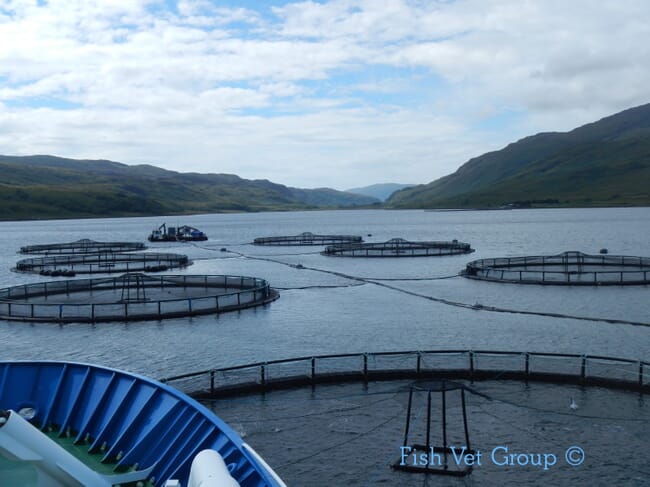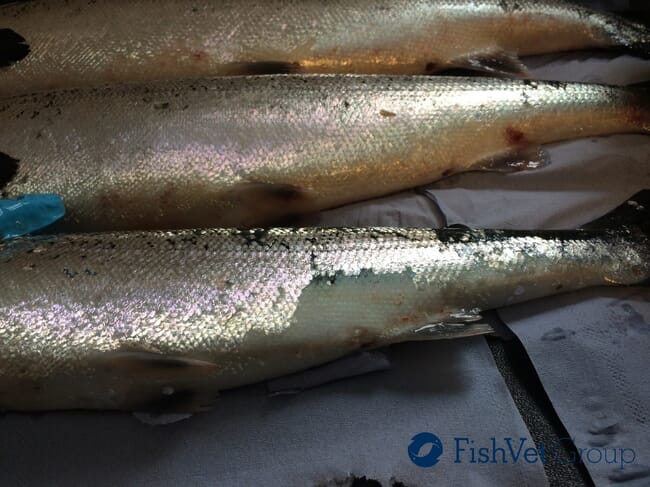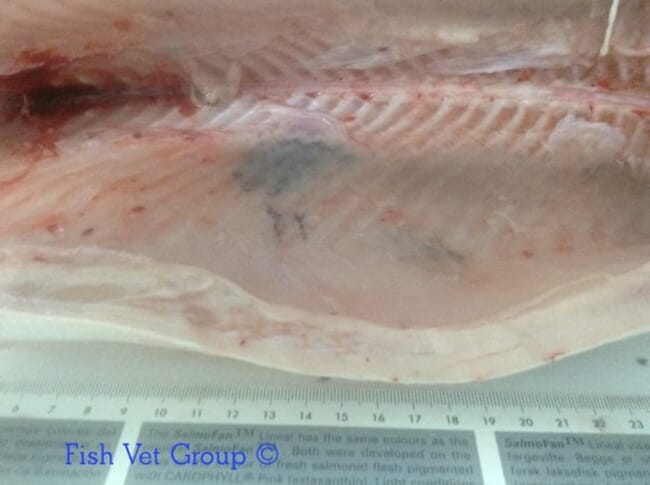Much effort has been applied to reduce handling and movement of fish in the marine phase of salmon production to minimise stress and manage triggers for disease. Current circumstances of increased requirements for bath treatments for amoebic gill disease (AGD), the increased use of physical methods for the removal of sea lice and an increase in pen furniture have however resulted in more opportunity for physical damage of fish. In addition, dual handling for double vaccination which has been prevalent for the last decade results in significant opportunity for physical damage in freshwater as well. This article highlights some injuries that have been observed due to these practices and the potential outcomes.
Stress and disease are linked
Physiological stress and physical injury can be contributing factors of fish disease and mortality in aquaculture. Stress and injury trigger acutely elevated plasma cortisol levels, which result in a blood sugar increase as liver glycogen is metabolised to provide an energy burst. At the same time the immune or inflammatory response of the fish is suppressed, leaving them more susceptible to disease pathogens. Fish are able to adapt to stress for a short period of time but if the stress triggers are frequent or continuous the ability of the fish to survive is considerably reduced.
Fish are constantly exposed to potentially pathogenic organisms, (bacteria, viruses and parasites) and mucous is the first physical barrier that inhibits the entry of disease organisms from the environment into the fish. It is also a chemical barrier containing enzymes and antibodies which can kill invading pathogens. Mucous is also an important lubricant, aiding swimming, and is important for osmoregulation. Any activity – including handling and chemical treatments – which removes or damages the mucous layer from the fish can significantly reduce its effectiveness as a barrier, resulting in excessive uptake of water by freshwater fish and dehydration in marine species. Scales and skin also act as an essential physical barrier which protects the fish and can be injured by handling, rough surfaces and overcrowding resulting in osmotic stress and risk of secondary infections.
Emerging problems
Some emerging problems and new technologies in salmon aquaculture have necessitated increased handling, resulting in potential damage or injuries. The industry should try to minimise these effects – we have to control the things we can control, because there are so many things we can’t. Farmers must ensure equipment is fit for purpose and has been inspected, so that it does not damage fish.
Physical damage can mean anything from loss of mucous and scales, blood loss and secondary bacterial infections, to deformities and death. Netting and crowding can also cause damage if there is overcrowding or damaged equipment and should be set up to allow the operation to be conducted as quickly and gently as possible. The use of knitted mesh nets rather than knotted nets will reduce injury and scale loss. Avoiding long transport distances (from tank to tank or pen to wellboat) and minimal bends and joints in the system are important. All pumps need to be checked regularly to ensure smooth pumping of stock from A to B, especially underwater pumps.
It is also important to adapt procedures for the care and welfare of cleaner fish such as wrasse and lumpfish during capture and transport to deployment on salmon farms, if they are stressed or damaged they will not be effective lice consumers. Adequate hides and resting surfaces also need to be provided within the sea pens.
In recent years there has been a significant increase in the amount of pen furniture such as ropes, feeding pipes and nozzles, cleaner fish hides and bird net supports installed in sea pens. Pen furniture injuries are mainly associated with concussion and this may be significantly underdiagnosed if not fully investigated. It has been observed that there were twice as many concussions with hamster wheel bird net supports as with top hats. Concussion mortalities increased when fish were 200-250g, peaking at around 400-500g, then decreasing as fish became more able to withstand impacts. Fish killed outright often had food in their stomachs. Other signs which can aid a diagnosis of death from pen furniture impacts are unilateral or bilateral exophthalmos (pop eye) of >20%, often with haemorrhages around or in the eye and up to 40% of affected fish will have a blood clot in the cranial cavity. Blood clots around the gills or livers are highly suggestive of a physical impact injury.

Mechanical hazards
In the past few years mechanical methods of removing sea lice have re-emerged, having been originally used in the early 1990s before being abandoned due to serious problems with physical damage to the salmon. There are a number of mechanical methods currently being deployed in the European salmon industry to physically remove sea lice from Atlantic salmon, including the Hydrolicer, Thermolicer and Skamik fish wash. While these methods have the major advantage of reducing chemical treatments and reducing lice levels in the environment they have the potential to remove protective mucous and scales from the fish, which are a vital first line defence against pathogens and the handling in itself may immunosuppress the fish.

Along with efforts to improve the design of the equipment and mechanical removal methods used it is essential that any negative impacts are assessed alongside these developments such as the system of mucosal mapping pioneered by Karin Pittman at the University of Bergen so that the impact on fish can be fully evaluated. The more complicated the process or machinery used the more likely that things can go wrong, so staff training, planning and constant vigilance is necessary when introducing new technologies to fish farming. The use of functional feeds to stimulate the immunity of the fish and increase mucous production prior and during these treatments may be a useful support action and again needs further evaluation.
Downgrades of farmed Atlantic salmon at harvest due to pigmented muscle changes, often called “black spots” due to melanisation of the white muscle, are an increasing problem in the salmon industry. Melanised or dark circumscribed muscle lesions are commonly found, especially in the cranio-dorsal and or cranio-ventral regions of the abdominal wall. In addition, unilateral and or bilateral linear melanised tracks have also been observed over recent years.
Previously all melanisation of salmon fillets was erroneously linked to misplaced vaccine or vaccination reactions, but it is now recognised that any injury (physical, nutritional, parasitic and infectious) to the musculature may result in chronic inflammation and melanisation of muscle lesions. Recent research has shown that there can be no difference in prevalence of such lesions between vaccinated and unvaccinated fish (Larsen et al, 2014). Histological investigation of pigmented muscle lesions show that they are dominated by inflammation and pigmented cells or melanomacrophages. Phagocytic activity implies the generation of potent oxidants, melanin is thought to protect host cells during this process. Therefore, any damaged tissue undergoing oxidation may attract melanin deposition as a reaction to injury. Much more investigation is required to identify all the potential causes of this serious flesh quality issue.

In conclusion, to reduce the incidence of physical injuries in salmon production and potential direct and indirect losses associated with these, handling operations should only be conducted when totally necessary. Additionally, ahead of any such procedure, it must be ensured that full risk assessment of all operations has been carried out, all equipment must be fit for purpose and staff involved are well trained and remain constantly vigilant for any deviations from normal outcomes. Think fish!
This article was originally published in the June 2017 issue of Sustainable Aquaculture Magazine.
